 The Subversionary: A Secret Alliance with Chaos is a solo art exhibition featuring a multimedia installation by SteviAnn Matijevic. It will be on view at the Mooney Center Gallery at The College of New Rochelle, 29 Castle Place New Rochelle, NY 10805, from October 29th to November 20th, 2016. Through themes of time, conspiracy, and confinement, The Subversionary: A Secret Alliance with Chaos appears to comment on the contemporary concern of corrupt individuals being in power and suggests that we live in a state of illusory free will and control. Upon entering the gallery, viewers will note the variety in media used; however, Matijevic’s distinct style and approach to art makes the installation successfully cohesive. Plaster and mesh wire structures which mimic human forms stand, hang or lie in the center of the room, two-dimensional works are displayed unframed on the walls, and a video is projected onto a single plaster “body” that stands amid one wall of two-dimensional works. The plaster forms of the installation are not bodies. They instead imitate fabric drapery, bringing to mind Ancient Greek or Roman attire. The viewer may infer from this that unseen individuals are or were standing in this procession that Matijevic has created, or recreated as proposed by her artist statement. The parallel between the ancient world and the plaster forms displayed here, present day, creates a reference to and theme of time in the exhibition. This is then reinforced by the predominant use of black, white and grey throughout the show. The wire bodies that hang and lie in the center of the room are displayed in a manner that seems almost sacrificial. With this inference, the two-dimensional works that fill the gallery rapidly take on a new meaning. The eyes from the drawings, all of which appear to be various types of portraits, seem to eerily watch viewers as they move through the space. The patterns and forms created by the materials of charcoal and ink in these works start to look more like bars, constraints on others who have also been sacrificed by these plaster beings (perhaps the demagogues referenced in Matijevic’s artist statement). The fact that the drawings have titles such as Sister, Father, and Mary Magdalene, points to the notion that these works may represent entities rather than specific individuals and exist as representational archetypes that have endured the passage of time confined, warning the viewer of the predetermined fates that await all those who follow bearing the same name or title. The Subversionary: A Secret Alliance with Chaos is an exceptional show that showcases Matijevic’s clear ability and skill, not only in developing a rich conceptual installation, but in creating individual works of art.
0 Comments
 “Alhambra” is a solo exhibition featuring artwork by Ibrahim El-Salahi. On display in the Salon 94 gallery, it is located at 243 Bowery New York, NY 10002. The show will be on view between March 1st, 2016 and April 23rd, 2016. Entering this gallery requires the viewer to descend a long staircase. The gallery consists of an entry way with a couple of works and one room at the bottom of the staircase where the majority of the art hangs on the four walls. Entering the one room, spectators note the consistent use of raw, earthy colors in El-Salahi’s artwork. The color palette feels very organic, similar to the colors of pottery or mineral rich rocks. The works include a number of paintings and drawings. All of the art features bodies and figures, most of who have been assembled through the emphasis of basic forms and shapes. The choices the artist has made to render these works suggest an opposition to the artifice. These shapes that El-Salahi uses to draw, though strange as representations of bodily forms, are not truly foreign or false as representational of the body. The shapes that the figures in all the works in the gallery are fashioned with are the basic shapes that all physical forms are comprised of. The work Flamenco Dancers (2012), with a width of 122 inches, hangs directly across from the long staircase. It was the first work that I, as a viewer, noticed. It drew me into the room to stand before it. Its placement alone on the wall and its size commands attention. With its large size, almost confrontational, the forms by which the figures in the work are composed of become an affirmative statement of existence. We inhabit and view bodies every day. Flamenco Dancers’ composition consists of organic forms with an emphasis on basic shapes that are assembled in a way that creates a recognizable human figure in natural colors. The work becomes an invitation by the artist to redefine the artificial application we may apply to our bodies, reconsider the foundations by which our physical bodies manifested from, and speculate as to what natural really is. Overall, the show Alhambra reclaims a sort of ancient truth of human form and existence. The way colors and shapes are composed in each of El-Salahi’s works reinforces the idea that despite what popular culture may claim, our foundations are not artificial. Image #1 Above
Ibrahim El-Salahi Flamenco Dancers, 2012 Oil on Canvas Overall dimensions: 66.875 x 122.875 x 2 inches Each Panel (6): 32 x 40.125 inches (IbEI I) 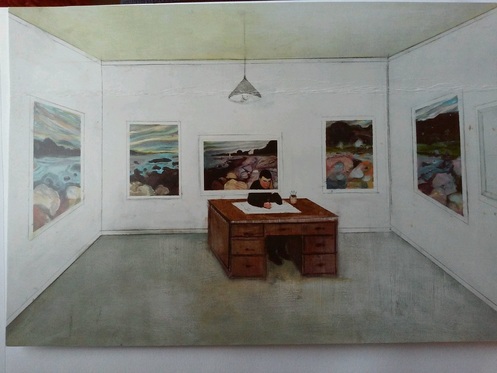 “Postcard Paintings” is a solo exhibition featuring works by William Wegman, an American artist. On display at the Sperone Westwater Gallery, it is located at 257 Bowery New York, NY 10002. The show will be up between March 17th, 2016 and April 23rd, 2016. The show includes a variety of paintings and mixed media works. Wegman takes postcards and books and places them on wooden panels which are then painted in ways that incorporate the existing images of those objects. Deceptively clever, the illusionistic composition Wegman creates within the pictorial plane makes the viewer consider how easy it is to fool the viewer and to be dubious. For example the work Inside Outside (2014) shows a postcard placed in the center of an oil painting. The image of a man on the postcard is then continued on the panel with oil paint. Wegman then makes the background of the rest of the postcard look as though it is a painting the wall of the room the man depicted is sitting in, keeping the white boarder of the postcard which imitates a frame. The viewer is presented with a contradiction. Can the man be in the room and the landscape? The duplicitous nature of the work causes the viewer to hesitate before any image that appears obvious visually. Wegman’s sense of humor is an element of the exhibit that becomes apparent the further you go in to the gallery. For example, the work, How--To—Do – It #3 (2015) features an encyclopedic book that appears to be from the 70s. It has been centered on the panel and depicts a late 90s image of a father fixing the television set in the living room of his house with his “mechanix illustrates” encyclopedia. Wegman, as seen with the other paintings in the show, continues the existing image of the book cover. However, he also adds a new element, a man who appears to be from ancient times stands in the background, in what looks like a mouth of a cave (paradoxically placed in the living room in the painting, with a hand lifted as though praising the man who is following the cliché, “how to” book. The show contains many engaging works. The use of objects with existing images which are then dispersed and hidden within each work makes the interaction between the art and viewer in this show extremely dynamic. Altogether, I would say “Postcard Paintings” is a show worth seeing if you are headed to the Lower East Side. Image # 1 Top
William Wegman Inside Out, 2014 oil and postcard on wood panel 30 x 40 inches SW 16047 Abrams: Illustrated p. 78 Image #2 Bottom William Wegman How -- To -- Do -- It #3, 2015 oil and mixed media on wood panel 14 1/2 x 29 1/2 inches SW 16050  Futuristic Fantasia is a show that features digital based artworks by Mecca Alim. The show is on display at The College of New Rochelle Mooney Center Gallery. It will be on exhibition between March 11th and April 10th, 2016. Futuristic Fantasia includes a variety of graphic design prints and a video. As you enter the gallery, you are drawn to a wall full of 36 inch tall prints. Across from that there are two works. The first includes a variety of smaller prints arranged in a pyramid formation and the second is a poster that comments on the domestic violence in Afghanistan. The final wall has a television that plays a short film on loop as well as several printed stills from the video. The various types of strokes and techniques Alim uses makes these prints and images feel very much as though they were drawn or painted with traditional materials such as charcoal, graphite or watercolors, rather than computer programs. This paradox makes the art visually intriguing and draws me in as a viewer. Two themes that are evident when walking through the show are personality and sexual identity. Many prints in the show appear to be portraits of individuals. This is seen in the work “Buddy Wall” (2015-2016), which includes several small prints in a pyramid formation, seems to represent different identities and personalities of particular people Alim is or was close to personally. In contrast, the larger works, such as “Confrontation” (2015), feature individuals who seem to represent the image of particular types of attitudes or personalities. The size of these works creates a sense of monument, presenting these people as pillars of historical importance in expression of physical or sexual identity. The viewer is then compelled to see these individuals as, perhaps, heroic figures of legend. The work, “V.D. Version 1” (2015), in particular, emphasizes the power of sexuality and asserting that sexuality. The figure in this piece looks like a creature from mythology. The luster of the creature’s skin is unnaturally shinny and there is a glow around him, her, or they. However, it appears as though this creature has a vagina enlarged to the length of the individual’s torso with teeth or thorns. The striking association with the female genitalia, the graphic elements applied to the image and the large size make the work a firm statement of female sexuality as powerful. Overall, Futuristic Fantasia invites the viewer to investigate and challenge his or her established definitions of what gender and sexuality can be. Image #1 Top
"V.D Version 1" (2016) 24 x 36 inches Image #2 Left "Buddy Wall" (2015-2016) 40 x 50 inches Image #3 Right " Confrontation (2015) 24 x 36 inches  Then and Now, 10 Years of Artists’ Residencies at the Center for Book Arts Castle Gallery at The College of New Rochelle 29 Castle Place New Rochelle, NY 10805 September8th-November 8th, 2015 The “Then and Now” art exhibit at the Castle Gallery, located at the College of New Rochelle, 29 Castle Place New Rochelle, NY 10805, features 60 artists who completed a residency at the Center for Book Arts in New York City. The exhibit displays work from each artist while they were residents, and work they completed later in their career, as they progressed in their creative practice of “book art.” The works comment on a plethora of themes, including socioeconomic, environmental, gender issues, immigration, political/ social reform and more. Each artist in the show took the opportunity to explore the meaning of “book,” and apply their own definitions to “book,” through their art. Diversity of work, artist and content is apparent while you walk through the gallery. Some forms of medium used to create these book arts include drawing, sculpture, painting, technology, and even performance. This variety of medium, including Karina Aguilera Skvirsky’s work, Los Pemas Que Declamba Mi Mamá (2014), and Hadassa Goldvicht’s work, Citrus (Secret Blessing), (2014) offers the viewer the idea that books are not restricted to their “traditional” rectangular, beginning, middle, end, and words criteria we typically apply to them. Perhaps the book is just an object that tells us a story, or an object that we read and “Then and Now” has demonstrated this. Aesthetically, there are some issues with the exhibit. The pieces do not seem to have enough space between them. There are too many works in the show which could have easily construed the same degree of diversity and margins of change with fewer artists. Thoughtful deliberation of pieces is difficult when the works are placed so closely together. It would take the viewer several visits in order to give each piece the consideration it deserves. The lack of negative space means a lack of focal point. The works blend, with the exception of a few works which invade your senses by auditory means, or physically invading the space you occupy. The works appear to require intimate interaction, as per the white gloves provided and the act of carefully flipping through pages. This intimacy is intimidating though, and with the stimulation of all the other works, the viewer can become dismayed at the idea of trying to concentrate on a sole, intimate, work. There are many good works of art in this show, which are worth viewing, but visitors must be wary; while visiting this show, the excessive materials and information that surrounds you may influence your viewing experience.
 Anne Truitt in Japan Matthew Marks Gallery 523 West 24th St. New York, N.Y. 10011 September 11th. – October 24th, 2015 Anne Truitt The Anne Truitt in Japan exhibit is on display at the Matthew Marks Gallery on 523 West 24th Street New York, N.Y., 10011. The show started September 11th and will continue until October 24th. This is a solo exhibit featuring the works of Anne Truitt. The gallery contains two rooms, one large front room and one smaller backroom. As you enter the first of the two rooms, the large spacing between each piece and the varying dimensions of the works in frames is immediately evident. Each frame uses glass and has a thin white border. This type of frame is used for every piece throughout the show. All pieces displayed in the exhibition are works on paper. Truitt uses some form of painting or drawing medium for these works on paper, which depict simple forms and lines. The paper does not fill the space within the frame but is centered. Some works use techniques such as complementary colors to create optic vibrations, while others use congruent forms of equal value to create the illusion of melding forms. Within the drawing plane, every form and line is curiously placed in unexpected arrangements. This curious arrangement is then reflected by the unusual sizes of each work. Some pieces are ‘tall and thin’ while others are ‘short and wide.’ Precision appears to be important in execution and presentation to Truitt as demonstrated by the exhibition. The second and final room continues the use of varying dimensions and evenly spaced works, as seen in the front room. These pieces are clearly larger than those in the first room, paradoxically being in the smaller of the two. These works are, aesthetically, a simple continuation of the pieces viewed when first entering the gallery. Geometric shapes and angles play on the preconceptions of the viewer. Lines create patterns on the drawing plane, but only certain parts of the pattern are filled, with different colors, and sometimes only partially. This reinforces the “unexpected” motif one can surmise to be part of Truitt’s intent for this body of work; from the shapes and angles that do not follow our assumptions, to how they are placed. Every work in the show only uses linear and geometric content. Having these images on paper with such obvious frayed edges seems counterproductive in Truitt’s theme of precision in all aspects of her exhibit. Overall, Anne Truitt in Japan show can be seen as an exhibit that challenges the viewer to move through space in a visually attentive and detail-oriented state. Image 1
Truitt '66 [29] 1966 Acrylic on paper 11 x 27 1/2 inches; 28 x 70 cm Image 2 Rice-Paper Drawing [15] 1965 Ink on Japanese rice paper 12 1/4 x 9 inches; 31 x 23 cm Image 3 Truitt ’67 [6] 1967 Acrylic on paper 27 ½ x 41 inches; 70 x 104 cm  Sarah Sze Tanya Bonakdar Gallery 521 West 21st Street. New York, NY 10011 September 10th-October 17th, 2015 Sarah Sze Sarah Sze has a solo show on display at the Tanya Bonakdar Gallery located at 521 West 21st Street, New York, NY. The show started September 10th and will continue until October 17th. The gallery consists of two floors. Each floor has two rooms. Upon first entering Sarah Sze’s exhibit on the first floor of the Tanya Bonakdra Gallery, I was not entirely sure what I was entering an art exhibit. A variety of found objects were scattered within the space. The scene was aesthetically similar to that of a snapshot of workmen doing handiwork in the building. Very much a captured moment, while entering the room, one felt as though they may be intruding an environment exclusively for a worker. The deceptive nature of these objects does not end just there, but also in the fact that these found objects have not been randomly placed. Each element, when examined further, indicate that their placement was done with great consideration, purpose, and precision. Many elements in the space have been balanced in a fixed point of a potentially devastating situation. Some examples include falling, breaking or cracking. However, they never reaching this tipping point, such as the objects which hang precariously by delicate or thin wire, or material, they remain fixed as you move around them. These pieces have also been placed in space which we as the audience seem to be ‘invading,’ thus increasing the tension in the room. The exhibition continued onto two back rooms, both shrouded in darkness. The rooms contained desks centered, and in demand of attention. Similar to the workmen’s ‘captured moment,’ these rooms elicit feelings of intrusion. The space evokes imagery of a studious, isolated individual at work. These rooms also employ the theme of anticipation of disaster, but also completion, through the display of various items, and elements such as current time, place, date and other numerical countdowns (count-ups). Both rooms contain a rock split in half. One half sits on the desk while the other is suspended in the air right above. The anticipation for the ‘other shoe to drop’ or in this case, the ‘other rock to drop,’ makes the viewer aware that, although the place we are in now is somewhat stable and balanced, our individual worlds are easily shattered; potential can easily be turned into kinetic. Some elements on these desks are already shattered even. The countdown displays are projected onto fragmented pieces and foundations of boxes stand on top of one another in spite of the fact that they are without sides, functionally entropy. Through the use of her work and the entire gallery space, Sze's exhibit creates an interactive, aesthetic experience. Criticism of art can be divided into three categories: descriptive, interpretive, and judgmental. Here I will post a few reviews that will contain one, two, or all three categories in order to critique an exhibition, artist, or series of works. I have highlighted a few examples in each article accordingly: descriptive interpretive judgmental  Ida Applebroog New York, at Hauser & Wirth by Tatiana Istomina Ida Applebroog has developed her signature style over the course of a five-decade career. Most of her works, from flip books and films to composite paintings and installations, generate elusive narratives through the juxtaposition and repetition of images. The same principle holds for her recent exhibition “The Ethics of Desire,” which could be viewed as a single montage sequence. The show began in the lobby of Hauser & Wirth’s Chelsea venue with a row of metal folding chairs, each with a hand-painted cartoon on its seat or back. The seemingly naive drawings are vaguely disturbing: a woman carrying a naked man piggyback, Jesus crucified on a ladder, a naked child holding an American flag. The piece is coyly titled Please Don’t Sit on These Works of Art (2014). The side gallery was dominated by a large multi-panel painting of nine naked women marching in file in thigh-high boots and silver helmets, their white bodies luminous against a background of yellow and purple. Much larger than life, the women exude a gleeful single-minded energy, and their seriated limbs create a reverberating visual rhythm. A triptych that hung on the other side of the room depicts three more nudes, in explicit postures exposing their sexual organs; the figures are about human-size, and the pictures were placed low, so that one’s eyes were level with their inscrutable faces. In the main gallery, the 1978 video It’s No Use Alberto was screened on a monitor, while the cut-out paper figures used to make it were displayed on wooden blocks nearby. A woman has intercourse with a headless man; an angel lectures to a couple; several well-dressed men and women huddle closely together. Illuminated by spotlights, the figures and their stark shadows seemed a vital extension of the video, and the video’s snippets of stories and music added to the suspenseful atmosphere of the installation. The majority of the cavernous space was occupied by a recent body of work. Suspended from the ceiling singly or in groups were more than 30 pieces of Mylar, each over 9 feet tall and showing a naked man or woman. Rows of folding chairs lined up between them divided the space into narrow segments, creating twisting paths for viewers and seeming more like an integral part of the installation than like potential seating. The figures are drawn in thick outlines, with flat areas of diffuse color here and there; each has a distinguishing attribute—a cowboy hat, a crucifix, a prosthetic leg, a protruding and scarred belly. These men and women present the cold appeal and vaguely aggressive postures of catwalk models. Despite their monumentality and composure, however, they look as fragile as oversize paper dolls. Press materials related the exhibition to Plato’s Symposium, a candid discussion of different levels and varieties of love. That classic text is in part a debate on the moral education of youth and the possibilities of shaping human desires to produce ethical behavior. The reference may be a clue or a distraction, but Applebroog’s work certainly entices us to scrutinize our impulses for their moral and social implications. Article Citation: Istomina, Tatiana. Review of, Ida Applebroog. Art in America September 16th, 2015. Web. September 20th, 2015. http://www.artinamericamagazine.com/reviews/ida-applebroog-1/  Ron Nagle at Matthew Marks, through Oct. 24 522 West 22nd Street Set in niches in the walls and plate-glass vitrines throughout the gallery, 35 abstract sculptures Ron Nagle produced between 1991 and 2015 stand poised for worshipful contemplation. The colorful, textural icons, almost all four by six inches, employ a variety of techniques, including slip-casting and hand-molding, as well as materials like glazed ceramic, polyurethane and epoxy. The West Coast artist's works are radiant, playful and witty, though the joke itself is uncertain. In Quiet Wood (2015), for instance, skinny purple fingers poke through holes in a ceramic base. Orange polyurethane drips over the base, like a Nickelodeon kid's show version of toxic waste. A selection of drawings and a group of bronze sculptures from Nagle's "Hands On" series (1991) are also on view. Pictured: Ron Nagle: Handsome Drifter, 2015, ceramic, glaze, catalyzed polyurethane, epoxy resin. 3 ¾ by 4 by 3 inches. © Ron Nagle. Courtesy Matthew Marks. Article Citation: Review of, Ron Nagle. Art in America. Web. September 20th, 2015. http://www.artinamericamagazine.com/exhibitions/ron-nagle/ 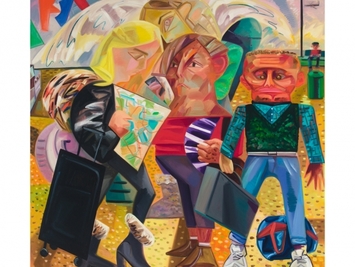 Dana Schutz at Petzel, through Oct. 24 456 West 18th Street Dana Schutz plots space more tightly than she used to. Her older works tweaked realist illusionism by clumping volume in one corner while letting loose in another, but her new body of work abounds in rigid angles and geometric patterning. She's painted pressurized environments that push at her canvasses' surfaces and sides. In a series of charcoal portraits, the caricatured figures' gazes and features are pressed eagerly, intensely outward. Fight in an Elevator (2015), which lends its title to the exhibition, is a jumble of limbs and smeared, stretched faces, glimpsed through the lines of half-open doors. The mise-en-scène seems to dramatize the act of painting itself, of paint gone wild in the plane set by the stretcher. The result distances the space of the viewer from the space of the work; Schutz's paintings are obsessive yet aloof, beguiling but uninviting. You're more of a voyeur than a viewer. The effect climaxes in As Normal as Possible (2015), where you're staring down a kid's dilated and reddened eyes under a flashlight's broad beam, as a police cruiser's lights blink behind him—you're a cop. Pictured: Dana Schutz: Swiss Family Traveling, 2015, oil on canvas, 84 by 88 inches. Courtesy the artist and Petzel, New York. Article Citation: Review of, Dana Schutz. Art in America. Web. September 20th, 2015. http://www.artinamericamagazine.com/exhibitions/dana-schutz/ Starting my blog today Thursday, September 10th, 2015. This begins my senior year as an art therapy student.
|
Emily B. PosnerNew York based artist and editor. Archives
November 2016
Categories |




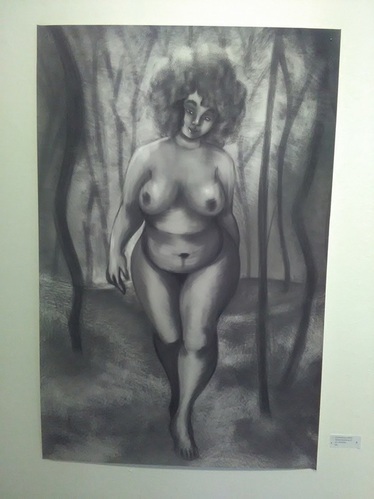




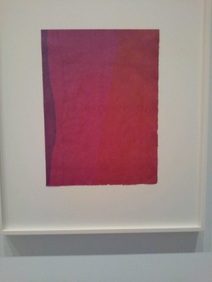
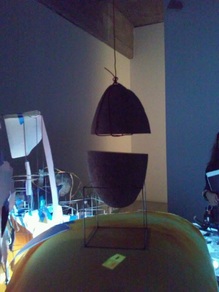
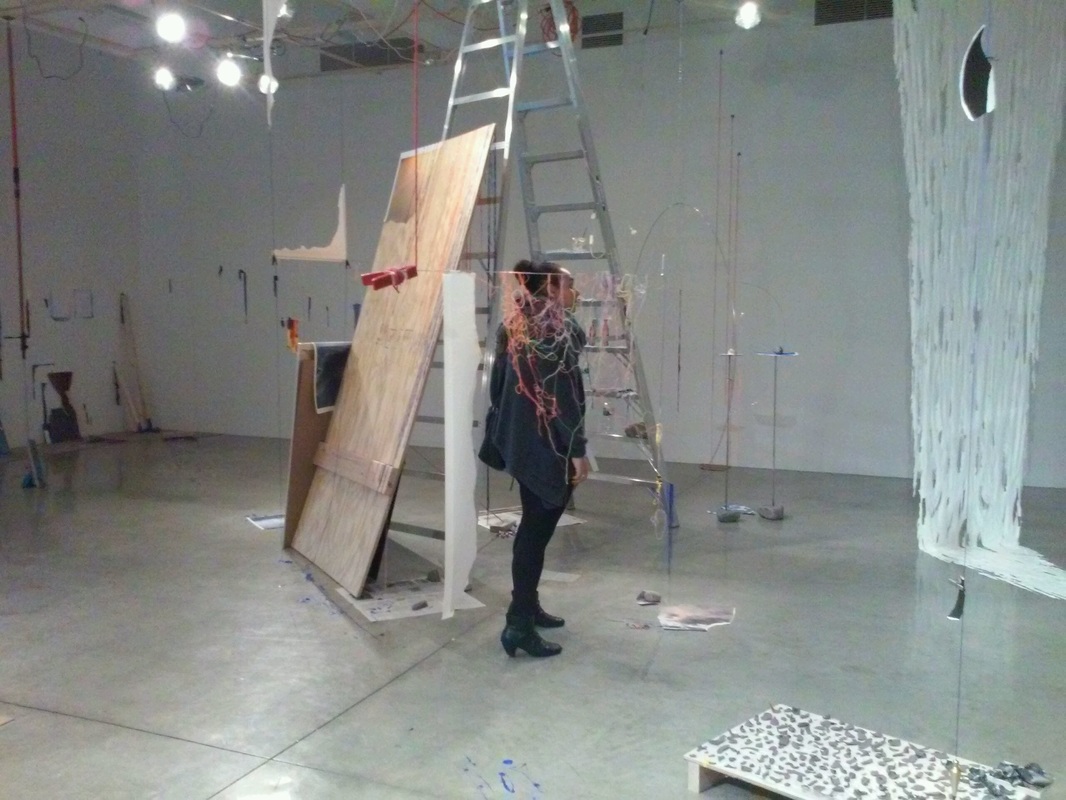

 RSS Feed
RSS Feed
